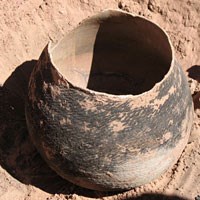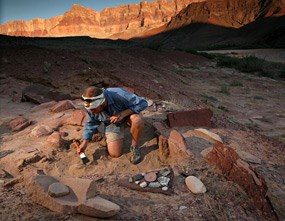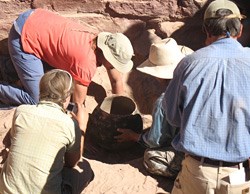|
Brian Gatlin, Park Ranger - Interpretation

On a hot day in October 2007, an archeologist lifted a slab from the floor of an ancient room, revealing a perfectly intact pot. People who lived here centuries ago used this large corrugated vessel for cooking or food storage. Now, it quickly drew a crowd of archeologists and their assistants. On an archaeological excavation, every artifact is an important part of the story that finally emerges, but a discovery like this was thrilling even for those who had spent years working in the field. Archeological sites are a non-renewable resource. When they disappear—whether through erosion, vandalism, or simply the passage of time—they are gone forever along with the knowledge they hold. Grand Canyon National Park, working with the Museum of Northern Arizona and eleven affiliated Native American tribes, has embarked on the largest excavation project seen in the park in nearly forty years. Beginning in 2007 and ending in 2009, the park will excavate nine of the most endangered sites along the river corridor. 
Photo courtesy of Dawn Kish National Park Service archeologists discovered the pot in a large ancestral Puebloan site along the banks of the river. As the archeologists dug carefully through the rooms, the artifacts they uncovered provided clues to the people's daily lives. The rooms held stone lined hearths for cooking fires, storage pits in the floor, and mealing bins where people once ground corn for their dinner. Other objects found at the site indicate that the canyon was not a barrier but a home that the people traveled through, gathering resources from different areas. The inhabitants grew corn nearby, but piñon nuts, juniper berries, and rabbit bones demonstrate that people along the river used resources from higher in the canyon and on the rims. The source of a bison femur is still a mystery! Varied potsherds, of different origin, show that pottery was traded back and forth across the canyon as well as made locally. 
Detailed study of the rooms reveals a complex and fascinating story. The ancestral Puebloans occupied this site off and on for a span of centuries. Each room showed layer upon layer of separate occupations. People came, built homes, stayed a generation or two farming along the river, and then left. Each time they left, they or others later returned to this familiar place. Archeology is a dynamic science. The final lab analysis of this project will provide a deeper understanding of the lives of the people who made this beautiful place their home. As this exciting series of excavations progresses, we will continue to refine and reshape our knowledge of Grand Canyon's human history. There is still much to learn and discover. If you find an artifact, do your part to preserve it by leaving it where it is and reporting its location to a park ranger. Related Information Grand Canyon National Park Archeological Resources The River Monitoring Program generates data regarding the effects of Dam operations on historic properties, identifies ongoing impacts to historic properties within the APE [Area of Potential Effect], and develops and implements remedial measures for treating historic properties subject to damage.
|
Last updated: July 23, 2018
